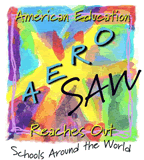|
AERO SAW
Evidence to Excellence Process
 An Evidence to Excellence professional development experience is a
three step process. In a large group setting, participants review the
E2E process using a case of student work provided by the facilitator.
In "critical friends" study groups of 4-5, participants share their
student work. One participant serves as facilitator, guiding the
group through each step of the process.
The E2E process:
An Evidence to Excellence professional development experience is a
three step process. In a large group setting, participants review the
E2E process using a case of student work provided by the facilitator.
In "critical friends" study groups of 4-5, participants share their
student work. One participant serves as facilitator, guiding the
group through each step of the process.
The E2E process:
-
The facilitator invites the teacher sharing the student work to
provide background information on the lesson focusing on the
following:
-
The "unpacked" standard/benchmark addressed
- The desired understanding
- The context of the lesson
- The task (assessment) given students
-
The teachers share the task with the members of the study group.
Using the E2E protocols, participants discuss the task, the student work,
and the assessment of the work. During this time, the sharing teacher
remains silent, recording what is being said in their reflection journal.
-
The sharing teacher shares their reflection with the group,
focusing on helping students who have not yet met the standard
and how the lesson might be enhanced to provide students greater
opportunity of performing at high levels.
In the large group discussions, participants are provided criteria for reflecting on their lessons and tasks.
The following is an outline of the kinds of criteria provided.:
-
Background information on lesson
-
Unpack the standards
Process for unpacking
-
Identify desired understanding
Criteria for identifying desired understanding
-
Identify evidence of understanding
Checklist for making sure evidence aligns with desired understanding
-
Identify lessons to achieve understandings
Criteria to consider in identifying challenging lessons
-
The Lesson
-
What teacher does (planning, teaching, implementing)?
Criteria for effective science lessons
Criteria for challenging tasks
-
What student does (student work)?
Protocol for examining student work
-
Refection
Read more about the Reflection Journal. [Next]
|
|

 An Evidence to Excellence professional development experience is a
three step process. In a large group setting, participants review the
E2E process using a case of student work provided by the facilitator.
In "critical friends" study groups of 4-5, participants share their
student work. One participant serves as facilitator, guiding the
group through each step of the process.
The E2E process:
An Evidence to Excellence professional development experience is a
three step process. In a large group setting, participants review the
E2E process using a case of student work provided by the facilitator.
In "critical friends" study groups of 4-5, participants share their
student work. One participant serves as facilitator, guiding the
group through each step of the process.
The E2E process: